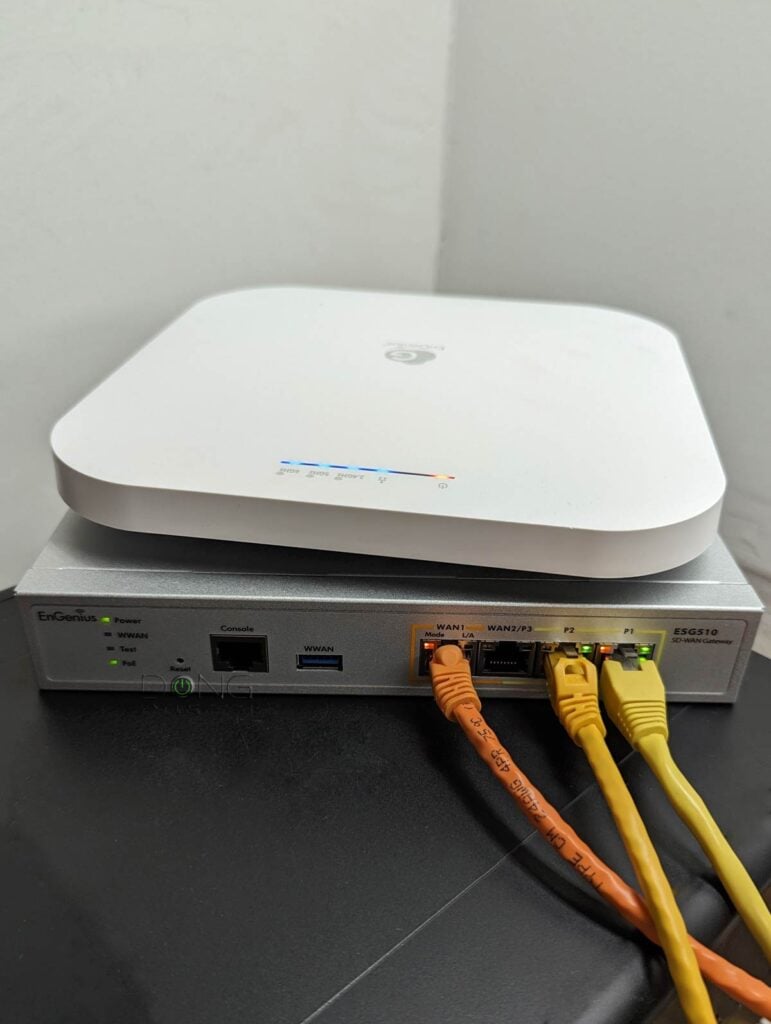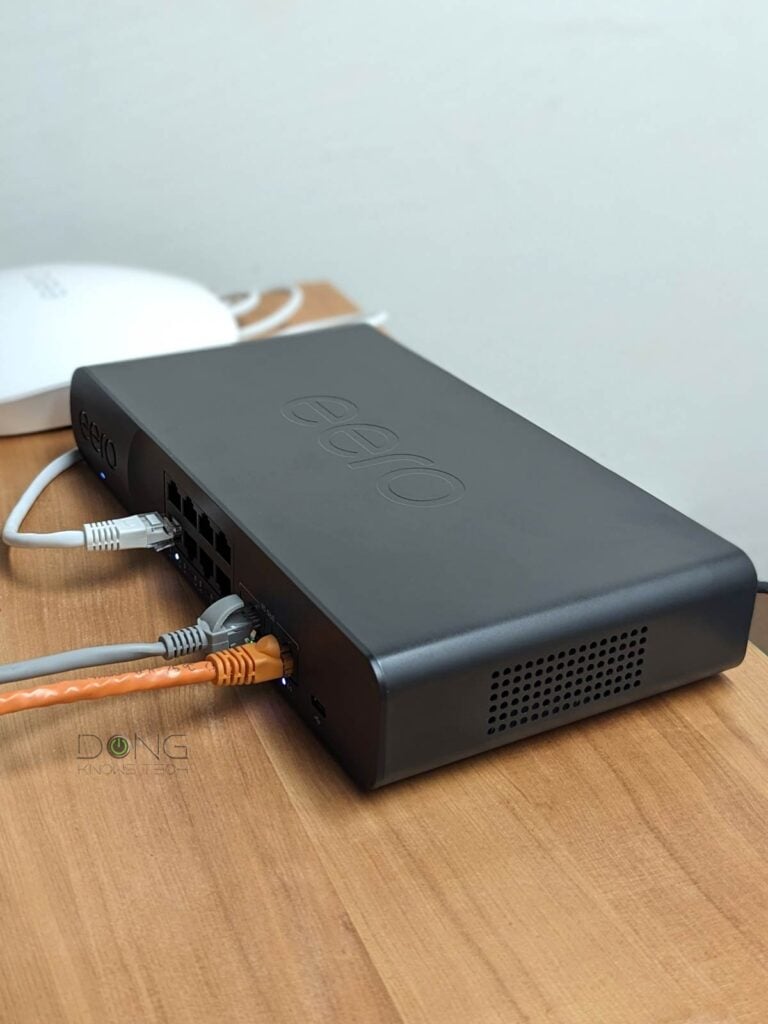Wi-Fi has become so popular that nowadays, obtaining a router without it—a non-Wi-Fi router—can be a challenge. Yet such a router is the best way to start when building a robust network, including one with the best Wi-Fi coverage.
This post will include the best five options among standard routers without built-in Wi-Fi that I’ve tested and used in real-world applications. They are the true representatives of the original meaning of the word “router.”
If you’re wondering why you’d want one or what a standard router has to do with a Wi-Fi network, you’re reading the right post.
Let’s dig in!
Dong’s note: I first published this post on September 11, 2024, and updated it on August 26, 2025, with the latest picks.


Why a non-Wi-Fi router?
Needless to say, when you don’t need or want Wi-Fi, a non-Wi-Fi router is a fitting option. The point here is that it remains an excellent choice, even when Wi-Fi is involved.
Technically, a Wi-Fi router is a standard router that includes a Wi-Fi access point (WAP) within the same hardware box. This convenient design works best when you only need one Wi-Fi broadcaster that can be placed at the ideal spot within your home for optimal coverage.
The problem is that in real life, you generally need to place the router where the Internet terminal enters the property. In nearly all homes, the Internet drop is not the ideal location to place the Wi-Fi router. Since the signals emanate from the router in a spherical pattern, the coverage is off-center, resulting in many parts of the home experiencing Wi-Fi “dead zones”.
For this reason, separating the Wi-Fi access point from the router provides flexibility for optimal hardware placement. You place the router unit near the terminal device and the Wi-Fi access point near the center of the desired Wi-Fi coverage area, with a network cable linking the two.
The point is that getting a non-Wi-Fi router is the right option in many homes where the router needs to be placed in the basement or a corner. Now, you can run a network cable to the center of the house and place a Wi-Fi access point there, rather than having it near the router.
Top five best non-Wi-Fi routers: The list
Below is the list of the top five best non-Wi-Fi routers you can bring home today, ranging from the most recommended to the least. I’ll also include their wired networking grades and recommended access points to use with each.
As you will notice, most of the best options below are from Ubiquiti. That’s because its UniFi family has proven in recent years to deliver the best networking solution for the home, in addition to its previous enterprise-class applications.
Thanks to the robust UniFi OS and feature-rich Network application, with its recent 9.4 version release featuring excellent new features and significant improvements, it’s safe to recommend a UniFi router to anyone with or without Wi-Fi needs.
1. Ubiquiti UniFi Cloud Gateway Fiber: A 10Gbps Multi-Gig/SFP+ PoE+ router


The UniFi Cloud Gateway Fiber (UCG-Fiber) is a top-tier 10Gbps-class console that, like all UniFi consoles, offers more functionality than just a standard router.
For example, it can be used as the NVR for an IP camera surveillance system, the controller for an IP phone system, and more. And it can do that all simultaneously. That, plus the compact design, top-tier hardware specs, non-compromising port-grade, and excellent performance, make its $279 price tag (no storage) a steal.
The UCG-Fiber works with all standalone access points, but it’s designed to host those from the same UniFi family and have a PoE+ port to power one. In this case, it’ll create a robust Wi-Fi system when you use multiple UniFi APs with it.
Pros
Top-tier hardware with three 10Gbps ports, four 2.5GBASE-T ports, PoE+ support, and an NVMe slot for NVR
Excellent and reliable real-world performance; can handle lots of concurrent UniFi devices (Wi-Fi access points, cameras, IP phones, etc.) and end-users
Compact and aesthetically pleasing design with everything for all users, from home to enterprise-grade
Lots of valuable features, each with tons of customization, comparatively affordable
Cons
Only one PoE+ port, no PoE++ support; SFP+ ports are less practical than 10GBASE-T
A Ubiquiti login account is required for the built-in Remote Management, as well as some other useful features, to work
Runs a bit warm, no SSD caddy is included in the non-storage version; no USB port or network-attached storage features
2. Ubiquiti Cloud Gateway Max: A 2.5Gbps Multi-Gig router


The UniFi Cloud Gateway Max is the more compact entry-level version of the UCG-Fiber above. Other than the port grade, it’s practically the same, making it a great deal at the $199 price tag (no storage) for those with 2.5Gbps bandwidth needs.
Pros
Excellent entry-level Multi-Gig performance for a comparatively low cost
Compact and aesthetically pleasant design with powerful hardware to handle a home or small business network via multiple simultaneous enterprise-class applications
A complete set of useful networking features, including powerful security/web-filtering and WireGuard VPN; excellent web user interface; useful mobile apps
No subscription is required
Cons
No 10Gbps ports or built-in PoE
A Ubiquiti login account is required for the mobile apps and built-in Remote Management, as well as other features, to work
Runs a bit warm, no SSD caddy is included in the non-storage version
3. Ubiquiti UDM Pro Max: A 10Gbps Multi-Gig/SFP+ router


The UniFi Dream Machine (UDM) Pro Max is a full-featured rack-mount console designed for large businesses. However, it’s also an excellent fit for a large home with a network rack. Like other UniFi consoles, the UDM Pro Max can do a lot more than an advanced router. It features two hard drive bays to accommodate storage, with a RAID 1 option available.
Alternatives:
Pros
Robust hardware to handle large-scale networks via multiple simultaneous enterprise-class applications; excellent overall performance
A complete set of useful networking features, including powerful security/web-filtering and WireGuard VPN; excellent web user interface; useful mobile apps
Dual drive support with RAID 1; no subscription required; runs relatively cool and quiet
Cons
Bulky design with only two SFP+ (10Gbps) and one 2.5GBASE-T ports, no 10GBASE-T port, no PoE support
A Ubiquiti login account is required for some useful features to work
4. ASUS ExpertWiFi EBG15: A Gigabit router


The EBG15 is the first standard router within ASUS’s new ExpertWiFi family. It’s a compact router with numerous advanced features for both home and business users. When coupled with ASUS’s AiMesh router or access points, it’ll be the host of a robust Wi-Fi network, making its sub-$90 price tag a great deal.
Pros
Super-compact and feature-rich with a robust web user interface
Part of the ExpertWiFi family with lots of advanced features, including Software-Defined Networks and powerful VPN options
Excellent optional ExpertWiFi mobile app; can handle up to 4 WAN connections simultaneously
Cons
No Multi-Gig or PoE ports; no built-in Wi-Fi
Single main SSID when hosting an AiMesh broadcaster
5. EnGenius ESG510: a 2.5Gbps PoE+ router


The EnGenius ESG510 is a standard business router—it represents many other options, such as the Firewalla Gold, without a built-in controller for Wi-Fi access points of the same ecosystem. Still, it has a built-in firewall, PoE+ ports, and four 2.5Gbps ports, enough to be well worth the current $300 street price. You can use it with any standard access points, though in this case, it’s best to use those with a centralized controller, such as the Omada or EnGenius FIT lineups.
Pros
Simple and straightforward to set up and use
Four Mult-Gig ports with Dual-WAN, PoE+ support
EnGenious Cloud Basic (free) has everything a home or SMB network needs, with a helpful Cloud-to-Go mobile app
Compact, practical design; runs cool
Cons
A bit pricey; zero customization with the built-in local web interface
The online portal requires a login account; no 10GBASE-T or SFP+ option
Requires some networking know-how to set up and manage
Extra: Amazon eero PoE Gateway: A 10Gbps PoE++ router


The eero PoE Gateway is an excellent piece of hardware thanks to its two 10Gbps ports and eight 2.5Gbps PoE+ ports. Unfortunately, it runs a firmware that’s very thin on features and settings while constantly nagging for the Eero+ subscription. If you only care about building a 10Gbps network, it’s still a decent option to consider, especially when you also want to go with the eero access points.
Pros
Two auto-sensing 10GBASE-T ports and eight PoE++ 2.5GBASE-T ports on the router and a 2.5GBASE-T POE port on the access point to deliver true multi-Gigabit wired performance
Compact design, easy to use
Good coverage, reliable performance
Cons
Expensive with extremely limited customizability and privacy risks
No web user interface (or desktop app) or command line support; no common business features, such as VLAN; all useful features (Dual-WAN, VPN, QoS, Parental Controls, etc.) require the eero Plus subscription
The router’s internal fan is a tad noisy; runs very hot
The takeaway
There you go. Above are the current non-Wi-Fi routers you can bring home today. Depending on your needs, each will give you the flexibility of building a Wi-Fi network with optimal hardware arrangement and cost.
Give this approach a try—get your home wired—and you’ll find a satisfying home network on the other side.
